ABS MAZDA MODEL CX-9 2018 Owners Manual (in English)
[x] Cancel search | Manufacturer: MAZDA, Model Year: 2018, Model line: MODEL CX-9, Model: MAZDA MODEL CX-9 2018Pages: 640
Page 33 of 640
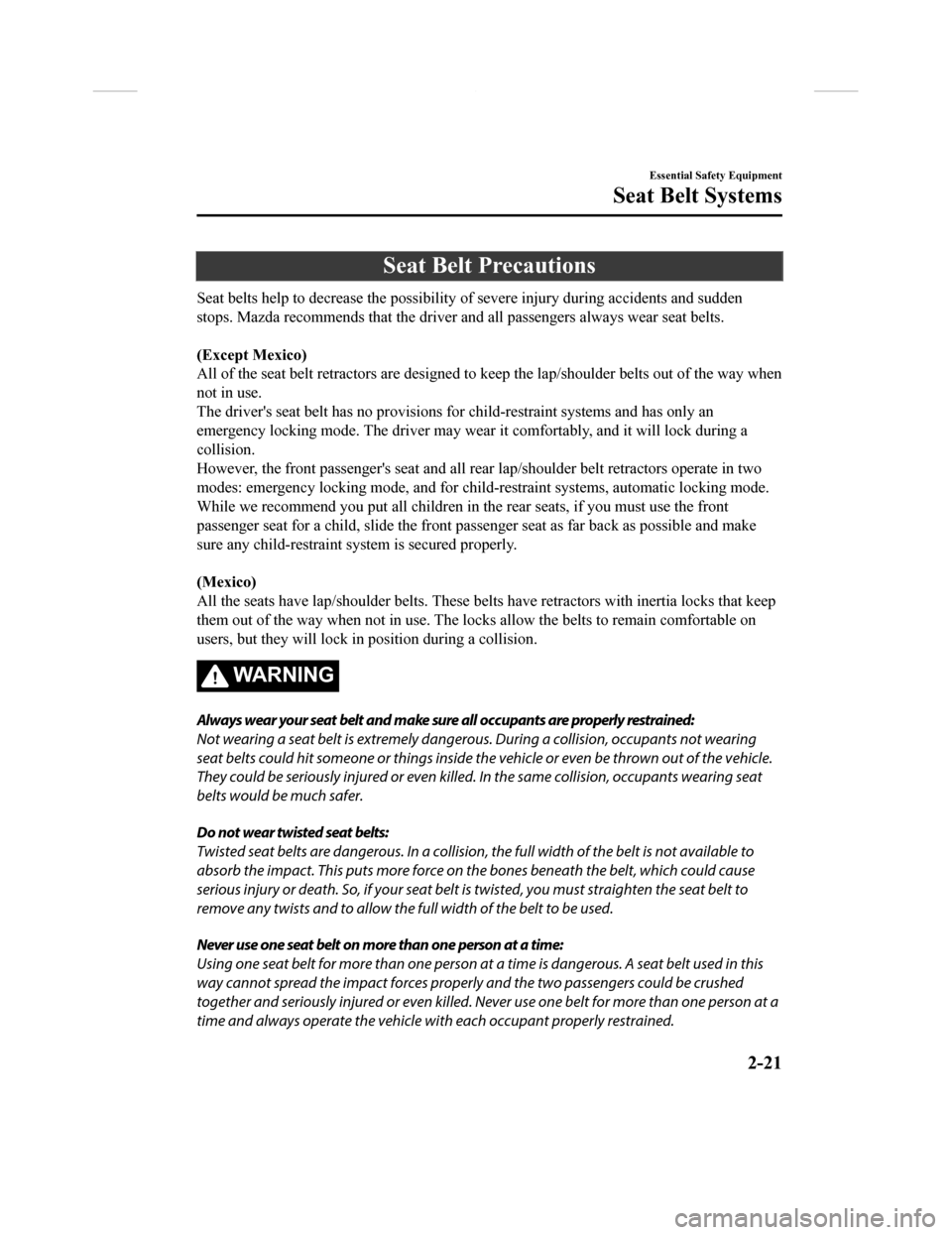
Seat Belt Precautions
Seat belts help to decrease the possibility of severe injury during accidents and sudden
stops. Mazda recommends that the driver and all passengers alwa ys wear seat belts.
(Except Mexico)
All of the seat belt retractors are designed to keep the lap/sh oulder belts out of the way when
not in use.
The driver's seat belt has no pr ovisions for child-restraint systems and has only an
emergency locking mode. The driver may wear it comfortably, and it will lock during a
collision.
However, the front passenger's s eat and all rear lap/shoulder belt retractors operate in two
modes: emergency locking mode, and for child-restraint systems, automatic locking mode.
While we recommend you put all children in the rear seats, if y ou must use the front
passenger seat for a child, slide the front passenger seat as far back as possible and make
sure any child-restraint sy stem is secured properly.
(Mexico)
All the seats have lap/shoulder belts. These belts have retract ors with inertia locks that keep
them out of the way when not in use. The locks allow the belts to remain comfortable on
users, but they will lock in position during a collision.
WA R N I N G
Always wear your seat belt and make sure all occupants are properly restrained:
Not wearing a seat belt is extremely dangerou s. During a collision, occupants not wearing
seat belts could hit someone or things inside the vehicle or even be thrown out of the vehicle.
They could be seriously injured or even killed. In the same collision, occupants wearing seat
belts would be much safer.
Do not wear twisted seat belts:
Twisted seat belts are dangerous. In a collision, the full width of the belt is not available to
absorb the impact. This puts more force on the bones beneath the belt, which could cause
serious injury or death. So, if your seat belt is twisted, you must straighten the seat belt to
remove any twists and to allow the fu ll width of the belt to be used.
Never use one seat belt on more than one person at a time:
Using one seat belt for more than one person at a time is dangerous. A seat belt used in this
way cannot spread the impact forces properly and the two passengers could be crushed
together and seriously injured or even killed. Ne ver use one belt for more than one person at a
time and always operate the vehicle wi th each occupant properly restrained.
Essential Safety Equipment
Seat Belt Systems
2-21
CX-9_8GC3-EA-17G_Edition1 2017-5-29 10:13:38
Page 139 of 640
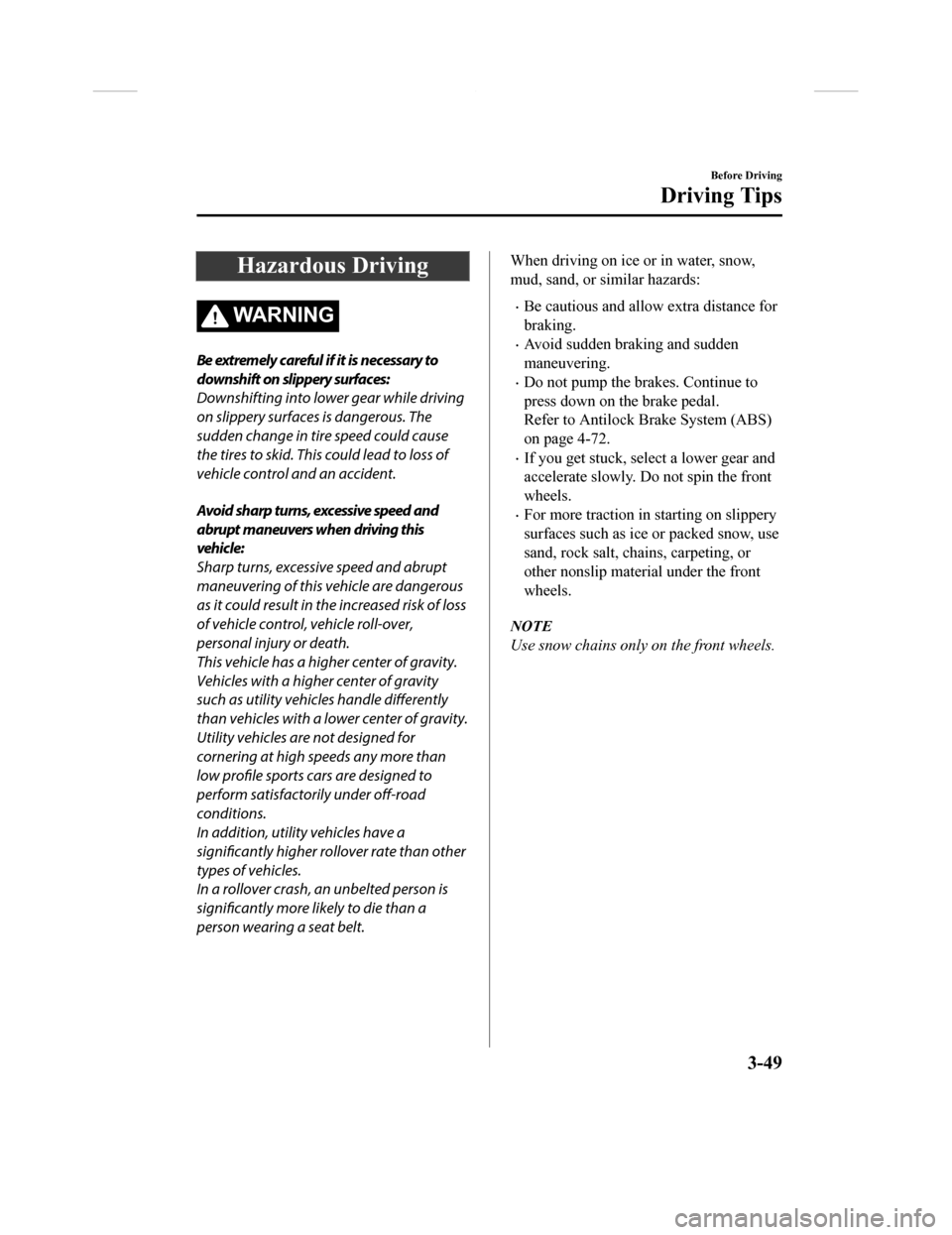
Hazardous Driving
WA R N I N G
Be extremely careful if it is necessary to
downshift on slippery surfaces:
Downshifting into lower gear while driving
on slippery surfaces is dangerous. The
sudden change in tire speed could cause
the tires to skid. This could lead to loss of
vehicle control and an accident.
Avoid sharp turns, excessive speed and
abrupt maneuvers when driving this
vehicle:
Sharp turns, excessive speed and abrupt
maneuvering of this vehicle are dangerous
as it could result in the increased risk of loss
of vehicle control, vehicle roll-over,
personal injury or death.
This vehicle has a higher center of gravity.
Vehicles with a higher center of gravity
such as utility vehicles handle differently
than vehicles with a lower center of gravity.
Utility vehicles are not designed for
cornering at high speeds any more than
low profile sports cars are designed to
perform satisfactorily under off-road
conditions.
In addition, utility vehicles have a
significantly higher rollover rate than other
types of vehicles.
In a rollover crash, an unbelted person is
significantly more likely to die than a
person wearing a seat belt.
When driving on ice or in water, snow,
mud, sand, or similar hazards:
•Be cautious and allow extra distance for
braking.
•Avoid sudden braking and sudden
maneuvering.
•Do not pump the brakes. Continue to
press down on the brake pedal.
Refer to Antilock Brake System (ABS)
on page 4-72.
•If you get stuck, select a lower gear and
accelerate slowly. Do not spin the front
wheels.
•For more traction in starting on slippery
surfaces such as ice or packed snow, use
sand, rock salt, chains, carpeting, or
other nonslip material under the front
wheels.
NOTE
Use snow chains only on the front wheels.
Before Driving
Driving Tips
3-49
CX-9_8GC3-EA-17G_Edition1 2017-5-29 10:13:38
Page 143 of 640

Driving In Flooded Area
WA R N I N G
Dry off brakes that have become wet by
driving slowly, releasing the accelerator
pedal and lightly applying the brakes
several times until the brake performance
returns to normal:
Driving with wet brakes is dangerous.
Increased stopping distance or the vehicle
pulling to one side when braking could
result in a serious accident. Light braking
will indicate whether the brakes have been
affected.
CAUTION
Do not drive the vehicle on flooded roads
as it could cause short circuiting of
electrical/electronic parts, or engine
damage or stalling from water absorption.
If the vehicle has been immersed in water,
consult an Authorized Mazda Dealer.
Overloading
WA R N I N G
Be careful not to overload your vehicle:
The gross axle weight rating (GAWR) and
the gross vehicle weight rating (GVWR) of
the vehicle are on the Motor Vehicle Safety
Standard Label on the driver's door frame.
Exceeding these ratings can cause an
accident or vehicle damage. You can
estimate the weight of the load by
weighing the items (or people) before
putting them in the vehicle.
Before Driving
Driving Tips
3-53
CX-9_8GC3-EA-17G_Edition1 2017-5-29 10:13:38
Page 155 of 640

4When Driving
Information concerning safe driving and stopping.
Start/Stop Engine.............................. 4-4 Ignition Switch........ ..................... 4-4
Starting the Engine....................... 4-5
Turning the Engine Off...............4-10
Instrument Cluster and Display............
........................................................... 4-12 Meters and Gauges..................... 4-12
Multi-information Display and INFO
Switch
*....................................... 4-20
Active Driving Display
*............. 4-28
Warning/Indicator Lights............4-31
Automatic Transaxle....................... 4-40 Automatic Transaxle
Controls...................................... 4-40
Shift-Lock System...................... 4-41
Transaxle Ranges........................4-41
Manual Shift Mode..................... 4-43
Driving Tips................................4-48
Switches and Controls..................... 4-49
Lighting Control......................... 4-49
Fog Lights
*................................. 4-54
Turn and Lane-Change
Signals........................................ 4-54
Windshield Wipers and
Washer........................................ 4-55
Rear Window Wiper and
Washer........................................ 4-59
Rear Window Defogg er.............. 4-59
Horn............................................ 4-61
Hazard Warning Flasher............. 4-61
HomeLink Wireless Control
System
*.......................................4-62
Brake................................................ 4-66 Brake System.............................. 4-66
Hill Launch Assist (HLA).......... 4-70
ABS/TCS/DSC/Trailer Stability Assist
(TSA)................................................ 4-72 Antilock Brake System
(ABS)..........................................4-72
Traction Control System
(TCS).......................................... 4-73
Dynamic Stability Control
(DSC)..........................................4-75
Trailer Stability Assist (TSA)..... 4-76
Fuel Economy Monitor................... 4-77 Fuel Economy Monito r...............4-77
Drive Selection................................. 4-79 Drive Selection........................... 4-79
*Some models.4-1
CX-9_8GC3-EA-17G_Edition1 2017-5-29 10:13:38
Page 186 of 640
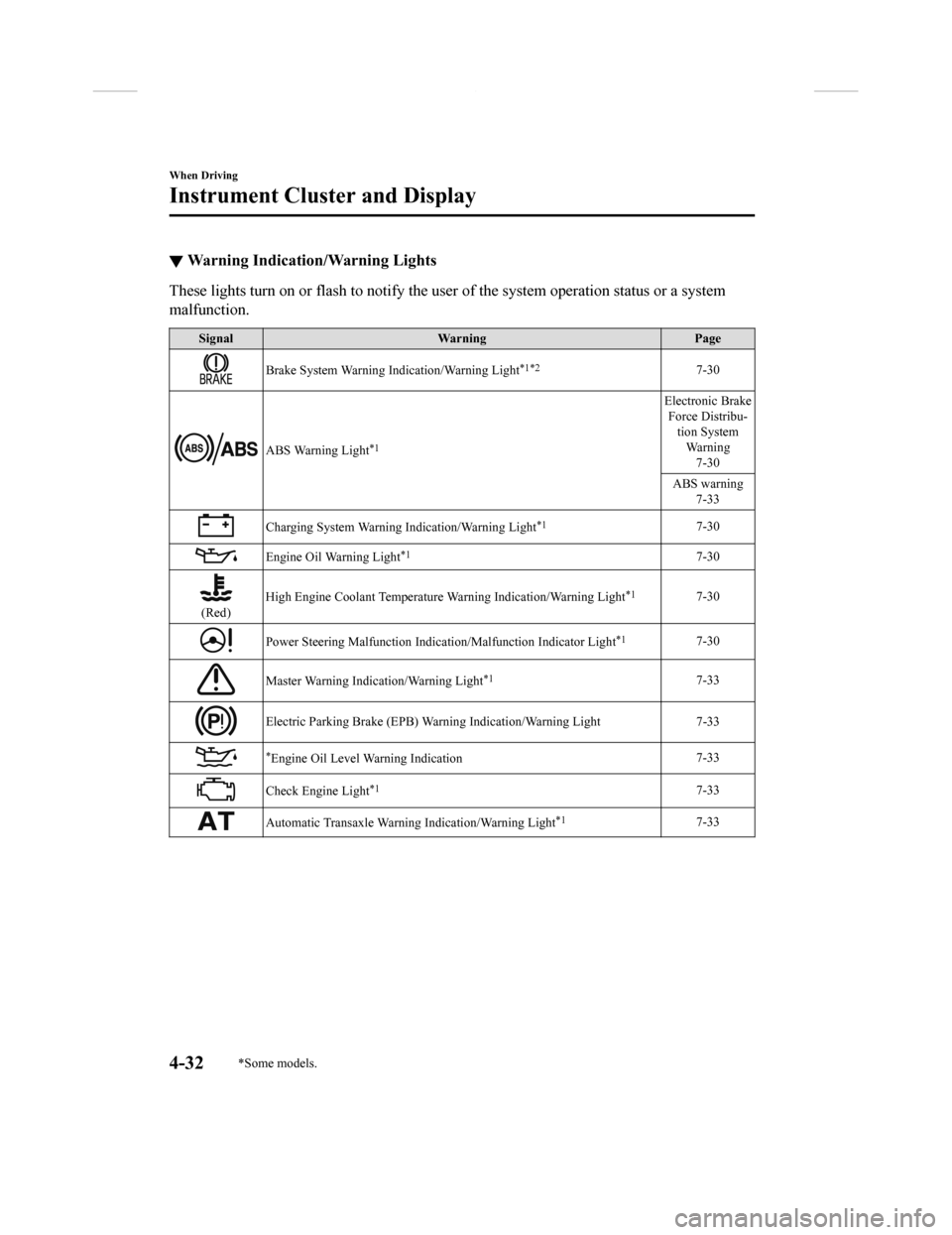
▼Warning Indication/Warning Lights
These lights turn on or flash to notify the user of the system
operation status or a system
malfunction.
Signal Warning Page
Brake System Warning Indication/Warning Light*1*27-30
ABS Warning Light*1
Electronic Brake
Force Distribu- tion System
Wa r n i n g 7-30
ABS warning 7-33
Charging System Warning Indication/Warning Light*17-30
Engine Oil Warning Light*17-30
(Red) High Engine Coolant Temperature Warning Indication/Warning Ligh
t
*17-30
Power Steering Malfunction Indication/Malfunction Indicator Light*17-30
Master Warning Indication/Warning Light*17-33
Electric Parking Brake (EPB) Warning Indication/Warning Light 7-33
*Engine Oil Level Warning Indication 7-33
Check Engine Light*17-33
Automatic Transaxle Warning Indication/Warning Light*17-33
When Driving
Instrument Cluster and Display
4-32*Some models.
CX-9_8GC3-EA-17G_Edition1
2017-5-29 10:13:38
Page 226 of 640

Antilock Brake System(ABS)
The ABS control unit continuously
monitors the speed o f each wheel. If one
wheel is about to lock up, the ABS
responds by automatically releasing and
reapplying that wheel's brake.
The driver will feel a slight vibration in
the brake pedal and may hear a chattering
noise from the brake system. This is
normal ABS system operation. Continue
to depress the brak e pedal without
pumping the brakes.
The warning light turns on when the
system has a malfunction.
Refer to Warning Indication/Warning
Lights on page 4-32.
WA R N I N G
Do not rely on ABS as a substitute for safe
driving:
The ABS cannot compensate for unsafe
and reckless driving, excessive speed,
tailgating (following another vehicle too
closely), driving on ice and snow, and
hydroplaning (reduced tire friction and
road contact because of water on the road
surface). You can still have an accident.
NOTE
•Braking distances may be longer on
loose surfaces (snow or gravel, for
example) which usually have a hard
foundation. A vehicle with a normal
braking system may require less
distance to stop under these conditions
because the tires wi ll build up a wedge
of surface layer when the wheels skid.
•The sound of the ABS operating may be
heard when starting the engine or
immediately after starting the vehicle,
however, it does not indicate a
malfunction.
When Driving
ABS/TCS/DSC/Trailer St ability Assist (TSA)
4-72
CX-9_8GC3-EA-17G_Edition1 2017-5-29 10:13:38
Page 227 of 640

Traction Control System(TCS)
The Traction Control System (TCS)
enhances traction and safety by controlling
engine torque and braking. When the TCS
detects driving wheel slippage, it lowers
engine torque and operates the brakes to
prevent loss of traction.
This means that on a slick surface, the
engine adjusts automatically to provide
optimum power to the drive wheels,
limiting wheel spin and loss of traction.
The warning light turns on when the
system has a malfunction.
Refer to Warning Indication/Warning
Lights on page 4-32.
WA R N I N G
Do not rely on the Traction Control System
(TCS) as a substitute for safe driving:
The Traction Control System (TCS) cannot
compensate for unsafe and reckless
driving, excessive speed, tailgating
(following another vehicle too closely), and
hydroplaning (reduced tire friction and
road contact because of water on the road
surface). You can still have an accident.
Use snow tires or tire chains and drive at
reduced speeds when roads are covered
with ice and/or snow:
Driving without proper traction devices on
snow and/or ice-covered roads is
dangerous. The Traction Control System
(TCS) alone cannot provide adequate
traction and you co uld still have an
accident.
NOTE
To turn off the TCS, press the TCS OFF
switch (page 4-74).
▼ TCS/DSC Indicator Light
This indicator light stays on for a few
seconds when the ignition is switched ON.
If the TCS, DSC or the Trailer Stability
Assist (TSA)
* is operating, the indicator
light flashes.
If the light stays on, the TCS, DSC or the
brake assist system may have a
malfunction and they may not operate
correctly. Take your vehicle to an
Authorized Mazda Dealer.
NOTE
•In addition to the indicator light
flashing, a slight lugging sound will
come from the engine. This indicates
that the TCS/DSC is operating properly.
•On slippery surfaces, such as fresh
snow, it will be impossible to achieve
high rpm when the TCS is on.
When Driving
ABS/TCS/DSC/Trailer Stability Assist (TSA)
*Some models.4-73
CX-9_8GC3-EA-17G_Edition1 2017-5-29 10:13:38
Page 228 of 640

▼TCS OFF Indicator Light
This indicator light
stays on for a few
seconds when the ignition is switched ON.
It also illuminates when the TCS OFF
switch is pressed and TCS is switched off.
Refer to TCS OFF Switch on page 4-74.
If the light remains illuminated and the
TCS is not switched off, take your vehicle
to an Authorized Mazda Dealer. The DSC
may have a malfunction.
▼ TCS OFF Switch
Press the TCS OFF sw
itch to turn off the
TCS. The TCS OFF indicator light in the
instrument cluster and TCS OFF switch
indicator light turn on.
Indicator light
Press the switch agai n to turn the TCS
back on. The TCS OFF indicator light and
TCS OFF switch indica tor light will turn
off.
NOTE
•When TCS is on and you attempt to free
the vehicle when it is stuck, or drive it
out of freshly fallen snow, the TCS (part
of the DSC system) will activate.
Depressing the accelerator will not
increase engine power and freeing the
vehicle may be difficult. When this
happens, turn off the TCS.
•If the TCS is off when the engine is
turned off, it aut omatically activates
when the ignition is switched ON.
•Leaving the TCS on will provide the best
traction.
•If the TCS OFF switch is pressed and
held for 10 seconds or longer, the TCS
can no longer be turned off even if the
TCS OFF switch is pressed.
In this case, the TCS OFF switch will
operate normally when the ignition is
switched ON again after being switched
OFF.
When Driving
ABS/TCS/DSC/Trailer St ability Assist (TSA)
4-74
CX-9_8GC3-EA-17G_Edition1 2017-5-29 10:13:38
Page 229 of 640
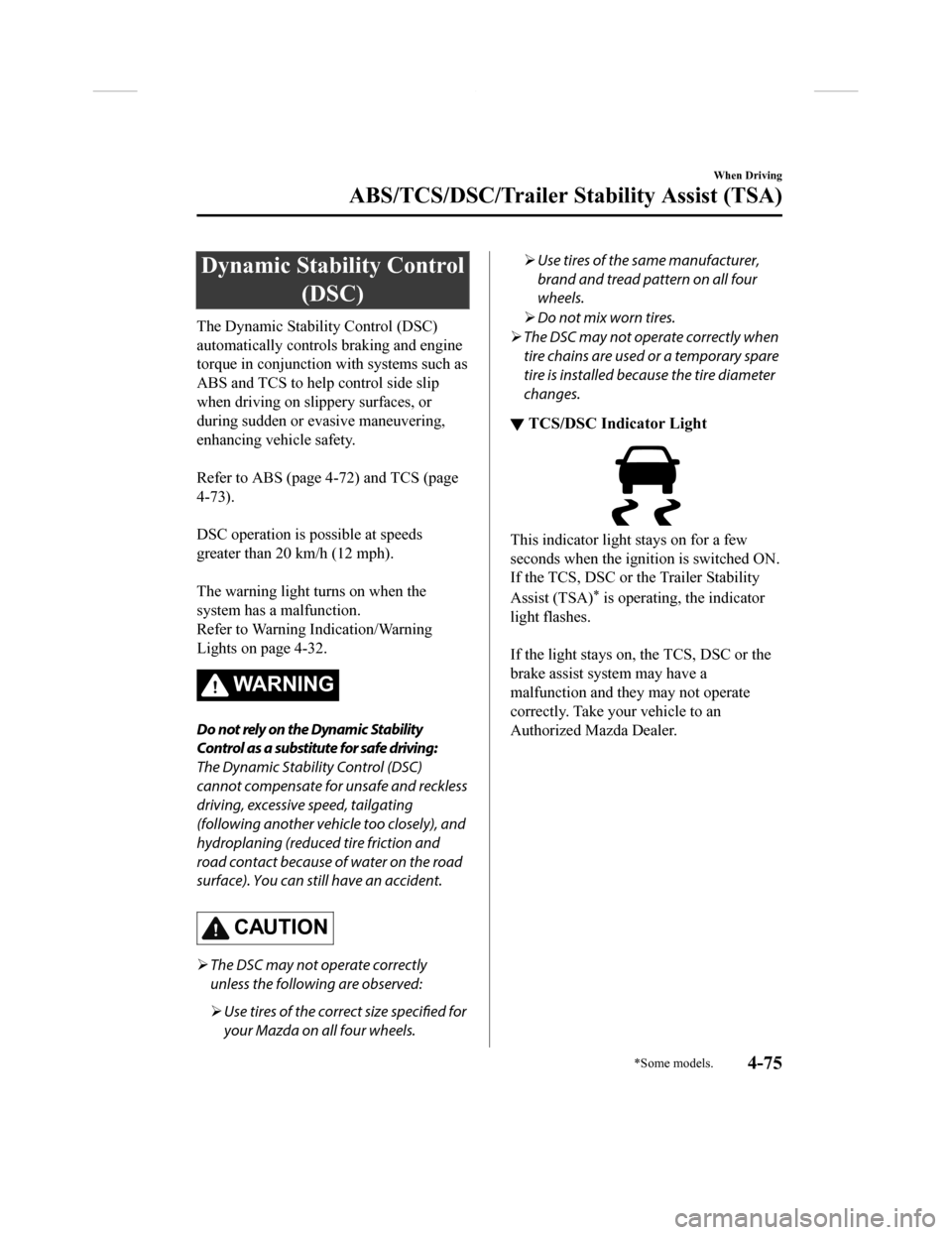
Dynamic Stability Control(DSC)
The Dynamic Stability Control (DSC)
automatically controls braking and engine
torque in conjunction with systems such as
ABS and TCS to help control side slip
when driving on slippery surfaces, or
during sudden or evasive maneuvering,
enhancing vehicle safety.
Refer to ABS (page 4 -72) and TCS (page
4-73).
DSC operation is possible at speeds
greater than 20 km/h (12 mph).
The warning light turns on when the
system has a malfunction.
Refer to Warning Indication/Warning
Lights on page 4-32.
WA R N I N G
Do not rely on the Dynamic Stability
Control as a substitute for safe driving:
The Dynamic Stability Control (DSC)
cannot compensate for unsafe and reckless
driving, excessive speed, tailgating
(following another vehicle too closely), and
hydroplaning (reduced tire friction and
road contact because of water on the road
surface). You can still have an accident.
CAUTION
The DSC may not operate correctly
unless the following are observed:
Use tires of the correct size
specified for
your Mazda on all four wheels.
Use tires of the same manufacturer,
brand and tread pattern on all four
wheels.
Do not mix worn tires.
The DSC may not operate correctly when
tire chains are used or a temporary spare
tire is installed because the tire diameter
changes.
▼ TCS/DSC Indicator Light
This indicator light stays on for a few
seconds when the ignition is switched ON.
If the TCS, DSC or the Trailer Stability
Assist (TSA)
* is operating, the indicator
light flashes.
If the light stays on, the TCS, DSC or the
brake assist system may have a
malfunction and they may not operate
correctly. Take your vehicle to an
Authorized Mazda Dealer.
When Driving
ABS/TCS/DSC/Trailer Stability Assist (TSA)
*Some models.4-75
CX-9_8GC3-EA-17G_Edition1 2017-5-29 10:13:38
Page 230 of 640
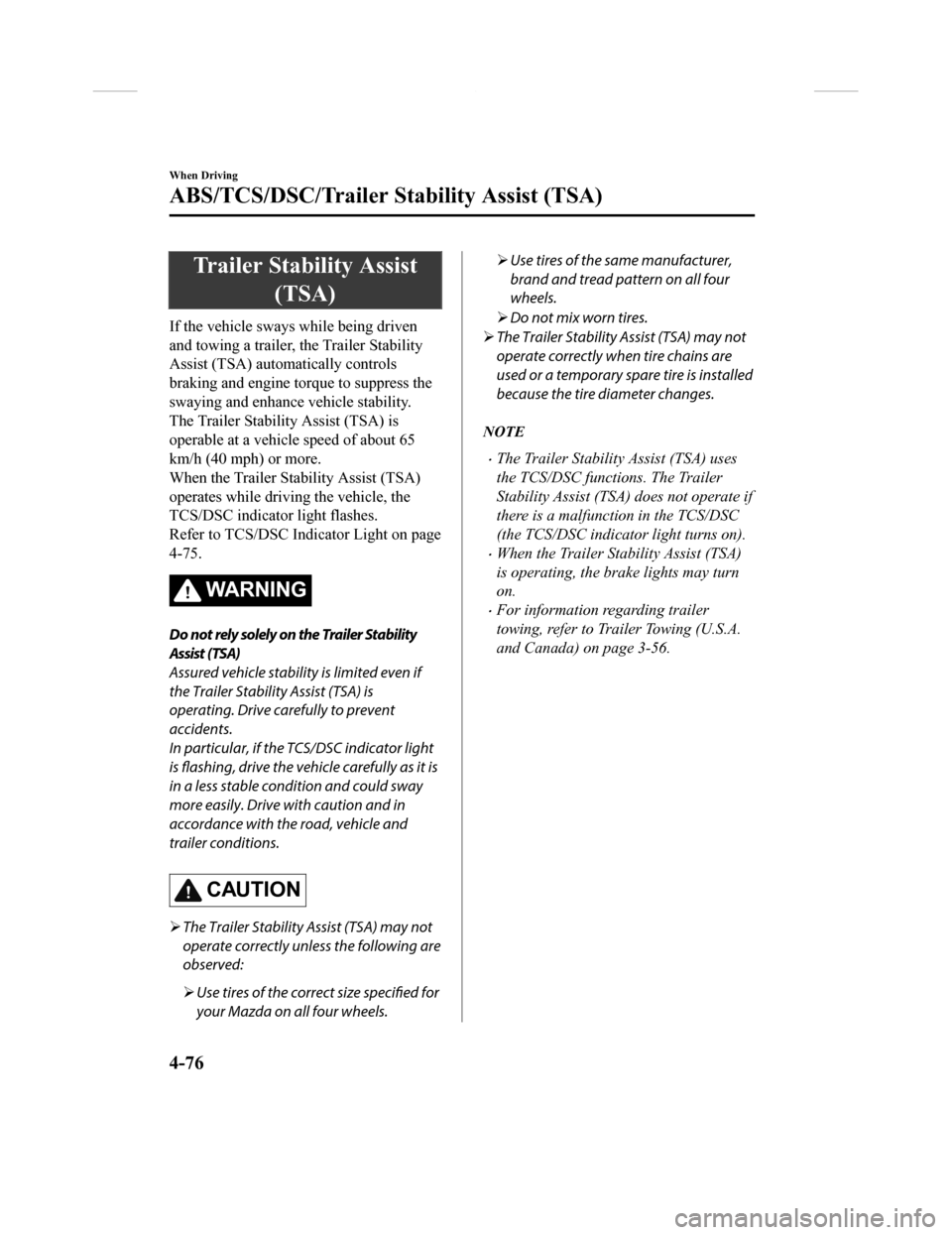
Trailer Stability Assist(TSA)
If the vehicle sways while being driven
and towing a trailer, the Trailer Stability
Assist (TSA) automatically controls
braking and engine torque to suppress the
swaying and enhance vehicle stability.
The Trailer Stability Assist (TSA) is
operable at a vehicle speed of about 65
km/h (40 mph) or more.
When the Trailer Stability Assist (TSA)
operates while driving the vehicle, the
TCS/DSC indicator light flashes.
Refer to TCS/DSC Indicator Light on page
4-75.
WA R N I N G
Do not rely solely on the Trailer Stability
Assist (TSA)
Assured vehicle stability is limited even if
the Trailer Stability Assist (TSA) is
operating. Drive carefully to prevent
accidents.
In particular, if the TCS/DSC indicator light
is flashing, drive the vehicle carefully as it is
in a less stable condition and could sway
more easily. Drive with caution and in
accordance with the road, vehicle and
trailer conditions.
CAUTION
The Trailer Stability Assist (TSA) may not
operate correctly unless the following are
observed:
Use tires of the correct size specified for
your Mazda on all four wheels.
Use tires of the same manufacturer,
brand and tread pattern on all four
wheels.
Do not mix worn tires.
The Trailer Stability Assist (TSA) may not
operate correctly when tire chains are
used or a temporary spare tire is installed
because the tire diameter changes.
NOTE
•The Trailer Stability Assist (TSA) uses
the TCS/DSC functions. The Trailer
Stability Assist (TSA) does not operate if
there is a malfunction in the TCS/DSC
(the TCS/DSC indicator light turns on).
•When the Trailer Stability Assist (TSA)
is operating, the brake lights may turn
on.
•For information regarding trailer
towing, refer to Trailer Towing (U.S.A.
and Canada) on page 3-56.
When Driving
ABS/TCS/DSC/Trailer St ability Assist (TSA)
4-76
CX-9_8GC3-EA-17G_Edition1 2017-5-29 10:13:38